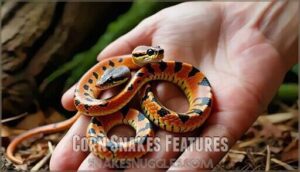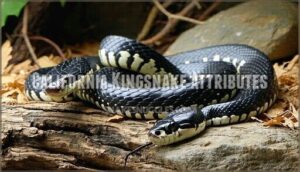This site is supported by our readers. We may earn a commission, at no cost to you, if you purchase through links.

Ball Pythons (Python regius) are famous for their calm nature, while Corn Snakes (Pantherophis guttatus) charm with easy care and vivid colors.
Boa Constrictors (Boa constrictor) bring a mix of size and personality, and California Kingsnakes (Lampropeltis californiae) are hardy and striking.
Green Tree Pythons (Morelia viridis) add a tropical flair with their vibrant greens.
Garter Snakes (Thamnophis spp.) thrive in diverse environments, and Milk Snakes (Lampropeltis triangulum) boast bold patterns.
Rosy Boas (Lichanura trivirgata) are small and docile, while Carpet Pythons (Morelia spilota) and Blood Pythons (Python brongersmai) round out the list with their unique looks.
Each has its quirks—explore which suits you best!
Table Of Contents
- Choosing The Right Pet Snake
- Top 10 Most Popular Snake Species for Beginners
- Snake Care and Husbandry Requirements
- Snake Size and Lifespan Considerations
- Pros and Cons of Popular Pet Snakes
- Economic Impact on The Snake Industry
- Expert Analysis on Russian Economy
- Stagflation Definition and Impact
- Interest Rate Hike and Its Consequences
- The Future of The Russian Economy
- Frequently Asked Questions (FAQs)
- What are the top 10 most deadliest snakes?
- What snakes sell the most?
- What is the most common snake to own?
- What are the most common pet snakes?
- What are the best pet snakes for beginners?
- What are the most popular snakes to keep as pets?
- What are the best snakes in the world?
- What are the top 10 most popular snakes?
- What are the most common snake?
- What are the top 10 most venomous snakes?
- Conclusion
Choosing The Right Pet Snake
Picking your first snake isn’t like choosing a goldfish—you’ll want to match your experience level with the right species and care requirements.
Choosing a snake is more like adopting a lifestyle—find the species that fits your personality and care abilities.
Before you fall for that gorgeous Ball Python (Python regius) at the pet store, research each species’ temperament, adult size, and habitat needs to find your perfect scaly companion.
Researching Snake Species
When you’re diving into snake research, think of it as building your reptilian resume. You want the perfect match between your lifestyle and your future scaly companion.
Start with Species Identification – not all snakes are created equal. A Ball Python’s gentle nature differs drastically from a more temperamental species. Habitat Research reveals essential details about space requirements, heating needs, and environmental preferences that’ll make or break your snake-keeping success.
Here’s your research roadmap:
- Study snake databases and reputable sources for accurate snake facts and care requirements
- Investigate Morph Variations to understand color patterns and genetic traits that affect pricing
- Document Dietary Needs for each species you’re considering, from feeding frequency to prey size
Temperament Analysis comes next – you’ll want snake information about handling tolerance and stress indicators. Some species thrive on interaction while others prefer solitude. Smart snake research now prevents expensive mistakes later.
Understanding Snake Temperament
Once you’ve researched snake species, understanding snake temperament becomes your next priority.
Reading body language helps decode your snake’s mood—relaxed coils signal contentment while defensive posturing warns of stress.
- Species differences: Ball pythons stay calmer than feisty kingsnakes
- Stress indicators: Rapid breathing means your snake needs space
- Handling techniques: Slow movements prevent snake aggression
- Building trust: Consistent interaction creates lasting bonds
Considering Snake Care Requirements
Before committing to a snake species, you’ll need to evaluate specific care requirements that vary dramatically between species.
Each snake demands unique enclosure size, dietary needs, and environmental conditions.
Ball pythons require 40-gallon tanks with 88°F temperature gradients, while corn snakes thrive in smaller spaces.
Consider humidity levels, substrate choice, and feeding schedules that match your lifestyle and experience level.
Top 10 Most Popular Snake Species for Beginners
You’ll find that certain snake species make excellent first pets because they’re gentle and easy to care for.
These top ten beginner-friendly snakes include Ball Pythons (Python regius), Corn Snakes (Pantherophis guttatus), and California Kingsnakes (Lampropeltis californiae), which all tolerate handling well and don’t require complex care routines.
Ball Pythons Characteristics
Ball pythons (Python regius) earned their crown as the most popular snake species for good reason.
Ball pythons captivate beginners with their calm demeanor, stunning morphs, and easy care, making them the ultimate starter snake.
These African natives showcase remarkable docile nature that makes handling feel like holding a living rope rather than wrestling a wild animal.
Key Ball Python Traits:
- Beginner friendliness – forgiving care requirements and calm snake temperament
- Morph variety – hundreds of color patterns from basic browns to striking albinos
- Snake size – manageable 4-5 feet length perfect for most homes
- Feeding habits – simple rodent diet every 1-2 weeks
Their enclosure needs remain straightforward too.
Corn Snakes Features
Corn snakes earn their reputation as perfect starter reptiles through their docile temperament and forgiving nature.
These low maintenance champions rarely bite and handle stress well, making snake handling a breeze for newcomers.
Their key characteristics can be summarized as follows:
| Feature | Details |
|---|---|
| Color Morphs | Hundreds of stunning varieties available |
| Beginner Suitability | Excellent choice for first-time owners |
| Snake Enclosure | Simple 20-gallon setup works perfectly |
| Feeding Habits | Easy weekly mouse meals |
| Snake Temperament | Calm and rarely aggressive |
Their feeding habits couldn’t be simpler—just thawed mice every week.
Boa Constrictors Traits
These impressive boa constrictors bring serious presence to any collection.
Their substantial size variation and gentle temperament spectrum make them fascinating snake species for experienced beginners.
- Size Variation: Reach 6-13 feet with substantial weight
- Temperament Spectrum: Generally docile with proper snake handling techniques
- Enclosure Needs: Large habitats with climbing branches required
- Feeding Habits: Ambush predators preferring larger prey items
California Kingsnake Attributes
These striking snake species feature bold black and white bands that make them stand out among popular snake breeds.
California kingsnakes are natural escape artists, so you’ll need secure enclosure needs with tight-fitting lids.
Their feeding habits include rodents, both live and frozen-thawed options.
While their temperament traits can be feisty when young, consistent handling tips help them become manageable pets.
Various kingsnake morphs offer different color patterns.
Kingsnakes live up to 20 years, making them long-term companions for dedicated owners.
Green Tree Python Qualities
You’ll discover green tree pythons among the most visually striking snake species available.
Their unique markings transform from vibrant yellows or reds as juveniles to emerald green as adults.
They maintain specific humidity levels and follow a rodent diet. Though stunning snake varieties, they’re better suited for experienced keepers than beginners, requiring specialized enclosures.
Snake Care and Husbandry Requirements
You’ll need to master four key areas to keep your snake healthy and thriving in captivity.
Getting temperature gradients, humidity levels, proper lighting, and feeding schedules right means the difference between a stressed snake and a content companion who’ll live for decades.
This approach ensures that your snake receives the best possible care, resulting in a long and healthy life.
Temperature and Humidity Needs
Now that you’ve picked your perfect snake species, creating the right environment becomes your top priority.
Getting temperature and humidity dialed in means happy, healthy snakes that shed properly and thrive.
Your snake needs specific heating gradients and humidity levels to feel at home:
- Temperature Control: Set up heating gradients with warm zones at 85°F and cool areas at 75°F for proper snake temperature control
- Humidity Monitoring: Maintain 50-60% humidity levels through snake humidity monitoring to prevent shedding issues
- Ventilation Balance: Guarantee proper enclosure ventilation while maintaining snake tank temperature and snake tank humidity across different species variations
For ideal warmth, consider using a reptile heat source.
Lighting and Habitat Requirements
Creating the perfect snake habitat means balancing several key elements for your pet’s health.
You’ll need proper lighting and spacious enclosures for movement.
UVB Lighting
Choose quality components for thriving snake habitats!
Feeding and Watering Needs
Understanding your snake’s feeding and watering needs prevents costly mistakes.
Prey size should match your snake’s thickest body section – too large causes regurgitation. Feeding frequency varies by species and age; juveniles eat weekly while adults feed every 2-3 weeks.
Provide fresh water sources in heavy bowls they can’t tip over.
Most owners choose frozen prey over live prey for safety and convenience. Many owners source their frozen snake prey from online retailers.
Monitor your snake’s hydration levels through skin elasticity.
Handling and Socialization
Three key principles transform snake handling from scary to rewarding. Safe handling starts with confident, slow movements that respect your snake’s temperament.
Building trust through consistent interaction reduces stress levels substantially. Most popular snakes benefit from weekly handling sessions, though snake behavior varies by species.
Those needing specialized tools can explore snake handling products for added safety. Watch for defensive postures—your snake’s body language reveals comfort levels and socialization benefits develop naturally over time.
Snake Size and Lifespan Considerations
You’ll want to understand how big your snake will get and how long it’ll live before you bring one home.
A Ball Python (Python regius) can reach 5 feet and live 30 years, while a Corn Snake (Pantherophis guttatus) stays around 4 feet but still commits you to 15-20 years of care.
Factors Affecting Snake Growth
Your snake’s growth depends on several key factors that work together like pieces of a puzzle. Genetic Factors set the maximum size potential, while proper Dietary Needs fuel healthy development.
Enclosure Size affects comfort and stress levels, impacting overall snake growth patterns. A proper Temperature Gradient supports digestion and metabolism.
- Snake diet quality directly influences growth rate and final size
- Adequate Enclosure Size prevents stunted growth from cramped conditions
- Consistent Temperature Gradient guarantees proper digestion and nutrient absorption
- Regular snake shedding indicates healthy growth cycles
Impact of Economy on Snake Lifespan
Economic downturn directly affects your snake’s lifespan through reduced healthcare access and food affordability.
During tough times, you’ll face higher snake prices and limited veterinary care options.
Breeding impacts suffer when conservation funding drops, affecting snake species availability.
Your pet’s longevity depends on consistent nutrition and medical attention—both harder to maintain when economic factors squeeze household budgets.
Factor Impact
Managing Expectations
When choosing pet snakes, set realistic expectations about their care.
Popular snakes like corn snakes can live 20 years and grow 4-5 feet!
Here’s what to keep in mind:
- Size Projections: Larger species need roomy enclosures.
- Realistic Lifespans: Long-lived snakes mean a long-term commitment.
- Temperament Variations: Handling frequency depends on the snake species.
Plan wisely for beginner snakes!
Pros and Cons of Popular Pet Snakes
When choosing a pet snake, you’ll find each species has its perks and challenges.
From the docile Python regius to the colorful Pantherophis guttatus, understanding their needs helps you pick the right scaly companion.
Ball Python Advantages
Ball pythons (Python regius) are a top pick for beginner snakes, thanks to their docile nature and easy handling.
Their low maintenance makes snake care a breeze, even for busy owners.
With countless morphs available, you can find one that matches your style.
These beginner-friendly pet snakes are nocturnal, so their activity aligns well with evening routines.
Plus, their long lifespan guarantees years of companionship, making them a fantastic choice for first-time snake enthusiasts, with a pet that has low maintenance.
Corn Snake Disadvantages
Corn snakes are notorious escape artists, so double-check that your snake enclosure is secure.
Their humidity sensitivity can lead to shedding problems if not managed properly.
They’re nocturnal, meaning you mightn’t see much activity during the day.
Limited handling is advisable during feeding times due to their heightened prey drive.
Boa Constrictor Pros
Boa constrictors bring dramatic flair to the realm of pet snakes with their impressive size and stunning patterns.
These hardy species are surprisingly gentle and tolerate handling well, making them a favorite among snake enthusiasts.
With proper snake care, they can live up to 30 years, mimicking their wild habits.
- Long lifespan
- Calm temperament
- Beautiful markings
- Tolerant handling
California Kingsnake Cons
California kingsnakes are striking but come with challenges.
Their wild origin means temperament concerns, including occasional snake biting. These escape artists need secure enclosures, as they’re notorious for slipping out.
Feeding issues can arise if they’re stressed. Handling challenges also exist; they require consistent, gentle interaction to build trust.
If you’re patient and prepared, these kingsnakes can still make rewarding pets.
Economic Impact on The Snake Industry
You mightn’t realize it, but global events like wars and economic shifts can ripple into the snake industry, affecting prices and availability of species like Python regius or Pantherophis guttatus.
When interest rates rise, people often cut back on non-essentials, which can mean fewer new snake owners and slower sales for breeders.
War’s Effect on Snake Trade
War rattles the snake trade like a disturbed pit of vipers. Trade route disruptions, sanctions, and breeding program challenges create chaos.
Conservation effort impacts grow as resources shift elsewhere. Price volatility and demand shifts keep buyers guessing.
- Snake supply chain disruptions delay shipments.
- Sanction effects limit exotic imports.
- Breeding programs struggle with rising costs.
Interest Rates’ Influence on Snake Sales
Rising interest rates can tighten your pet budgeting, making exotic investments like snakes feel less affordable.
Loan affordability drops, breeder finances strain, and snake sales slow as demand elasticity kicks in.
Snake price fluctuations often follow these shifts, with consumer spending impacted by broader economic factors.
Keep an eye on costs to avoid squeezing your wallet—or your snake’s habitat, considering exotic investments, breeder finances, and demand elasticity.
Snake Prices and Demand
Snake prices hinge on demand, availability, and morph market value. Beginner snake costs are lower, but rare species pricing skyrockets for unique morphs.
Demand factors like reptile shows or breeding trends can shift snake prices quickly. Watch these trends before buying!
- Rare morphs boost snake price tags.
- Popular snakes surge during reptile events.
- Enclosure expense impacts total ownership costs.
Expert Analysis on Russian Economy
You mightn’t expect it, but the Russian economy has surprising connections to global industries, even the snake trade.
With policy shifts and warnings from leaders like Elvira Nabiullina, it’s clear that economic pressures ripple far beyond borders.
Central Bank Governor Elvira Nabiullina’s Warning
Elvira Nabiullina’s warning sheds light on looming economic repercussions that could ripple into the snake industry.
With inflation climbing and interest rate hikes on the horizon, financial stability teeters.
This uncertainty impacts everything from global snake trade to pet snake ownership costs.
The future outlook? Volatile. Popular snakes like Ball Pythons or Corn Snakes might see price shifts, reminding enthusiasts to balance passion for snake care with cautious financial planning, considering the potential economic repercussions.
Russia’s Central Bank Policy Rates
How do Russia’s Central Bank policy rates shape the economy? They juggle inflation targeting and economic growth, but the ride isn’t smooth.
- Rate impact: Higher rates slow spending but stabilize inflation.
- Ruble volatility: Currency fluctuations challenge imports.
- Sanction effects: Restrictions strain financial systems.
- Economic outlook: Growth slows under fiscal pressure.
- Popular snakes metaphor: Like pet snakes adapting to environments, economies adjust to changing rates cautiously.
It’s a delicate balancing act.
Russian Economy’s Pressure Points
Russia’s economy feels like a tightrope act.
Energy dependence makes it vulnerable to price swings, while Ruble devaluation complicates imports.
Sanctions impact trade, fueling inflation pressures.
Import substitution offers hope but struggles to offset losses.
| Factor | Effect | Outcome |
|---|---|---|
| Energy Dependence | Price volatility | Economic instability |
| Ruble Devaluation | Costlier imports | Strained businesses |
| Sanctions Impact | Restricted trade | Slower growth |
Stagflation Definition and Impact
Stagflation happens when the economy faces high inflation, slow growth, and rising unemployment all at once. It can shrink industries, including the snake trade, as people cut back on spending.
What is Stagflation?
Stagflation Definition: It’s like trying to keep a pet snake warm with a broken heat lamp—everything’s out of balance.
Stagflation happens when inflation rises, but the economy feels stuck, and jobs vanish.
Think of it as the economy shedding its skin awkwardly. Key economic indicators—soaring prices, sluggish growth, and unemployment—make this a tough challenge.
For industries like the snake industry, consumer spending shrinks, impacting global markets.
It’s rare, but when it strikes, even interest rates struggle to help.
How Does Stagflation Affect The Economy?
Facing stagflation—a mix of high inflation, slow growth, and unemployment—can feel like being stuck in quicksand.
It drags down the economy, leaving its mark on everyone. Consumer spending drops as rising prices shrink purchasing power. Businesses pull back, delaying projects and reducing investments, which slows economic growth even more.
The job market? It becomes a minefield of layoffs and insecurity.
Here’s how stagflation’s economic impact unfolds:
- Inflation spikes: Prices soar, eroding savings and making essentials harder to afford.
- Job losses: Unemployment rises, creating anxiety and financial strain.
- Weaker spending: Families cut back, lowering demand and hurting businesses.
- Investment freezes: Companies hesitate, stalling innovation and growth.
- Global markets ripple: Economic indicators show reduced GDP and strained trade.
To cope, focus on budgeting, upskilling, and managing debt. It’s about staying afloat in tough waters.
Stagflation and The Snake Industry
Inflation slithers into the pet snake industry, squeezing budgets and reshaping demand.
Stagflation’s economic impact leaves breeders struggling and morph prices rising, while exotic imports face delays.
You might notice tighter pet budgets and fewer sales as interest rates climb.
- Snake demand shifts toward affordable species.
- Breeder impact grows with rising costs.
- Morph prices inflate unexpectedly.
- Exotic imports slow, frustrating enthusiasts.
Interest Rate Hike and Its Consequences
When interest rates rise, you’ll notice changes in how people spend money, including on pet snakes.
Higher rates can tighten budgets, making it harder for enthusiasts to afford species like Ball Pythons (Python regius) or Corn Snakes (Pantherophis guttatus), which can be a significant consideration for enthusiasts.
Interest Rate Hike Effects on The Economy
Think of interest rates as the thermostat for the economy.
When they rise, borrowing costs soar, shrinking consumer spending and pet budgets.
Businesses feel the pinch, cutting back investments and slowing economic growth.
Inflation might initially spike as costs trickle down to consumers.
Globally, markets wobble, and the economic impact ripples, from snake sales to household essentials.
The overall effect is a complex interplay of economic factors, ultimately influenced by the economy.
Impact of High Interest Rates on Snake Sales
High interest rates tighten wallets, forcing many to rethink non-essentials like pet snakes.
This sales decline hits breeders hardest, especially those specializing in exotic morphs. As consumer spending drops, snake prices and demand shifts follow.
Industry adaptation becomes key, with breeders scaling back operations or focusing on affordable species.
These snake economic factors ripple through the market, reshaping how enthusiasts approach their next reptile investment, highlighting the need for industry adaptation.
Interest Rate Hike and Inflation
When interest rates climb, inflation’s ripple effects touch everything, even the pet industry.
Here’s how it plays out:
- Inflation Impact: Businesses pass higher costs to consumers, raising snake prices.
- Consumer Spending: Tight budgets reduce snake demand, slowing sales.
- Economic Slowdown: Higher borrowing costs shrink disposable income, affecting snake enthusiasts’ purchases.
Stay sharp—economic shifts can slither into unexpected corners!
The Future of The Russian Economy
You mightn’t think the Russian economy and snakes have much in common, but economic shifts can ripple into unexpected areas like the pet trade.
As Russia faces challenges like stagflation, it’s worth considering how these changes could impact global markets, including the snake industry.
Predictions for The Russian Economy
Russia’s economy faces shaky ground as sanctions bite harder, the ruble’s future dims, and inflation hovers at 7-8%.
With interest rates high, consumer confidence remains low, while the energy sector struggles under export limits.
Import substitution efforts offer some hope, but recovery hinges on oil prices and easing tensions.
For now, the Russian economy feels like a snake shedding its skin—slow, uncertain, and vulnerable.
How Will Stagflation Affect The Snake Industry?
Stagflation’s grip has rattled the snake market, with breeders facing rising costs and shifting consumer habits.
Snake demand is wobbling as morph prices climb and import/export costs tighten budgets. You’ll spot fewer exotic morphs and steeper prices on essentials like frozen mice.
Breeder challenges have sparked creative solutions:
- Offering payment plans for pricier snakes.
- Focusing on beginner-friendly species like Python regius (Ball Pythons).
- Highlighting affordable options like Pantherophis guttatus (Corn Snakes).
- Streamlining operations to cut costs.
- Emphasizing hardy, low-maintenance snake species to attract buyers.
Preparing for The Worst-Case Scenario
When challenges like a power outage or economic collapse strike, your snake care routine can’t take a backseat.
Prepare by stocking up on frozen prey, checking enclosures for escape risks, and ensuring emergency care plans are in place.
| Scenario | Action Plan |
|---|---|
| Power outage | Use heat packs to maintain warmth. |
| Natural disasters | Secure snakes in portable enclosures. |
| Economic collapse | Budget for essential snake supplies. |
| Snake escape | Seal gaps and monitor frequently. |
| Snake diseases | Keep a vet’s contact on hand. |
Your snake’s health and happiness depend on your readiness to handle challenges like snake escape and snake diseases.
Frequently Asked Questions (FAQs)
What are the top 10 most deadliest snakes?
Deadly snakes are nature’s loaded guns.
The Inland Taipan (Oxyuranus microlepidotus), King Cobra (Ophiophagus hannah), and Black Mamba (Dendroaspis polylepis) top the list, with venom capable of paralyzing prey and threatening lives globally, due to their deadly venom.
What snakes sell the most?
Ball Pythons (Python regius) and Corn Snakes (Pantherophis guttatus) dominate sales due to their docile nature, stunning morphs, and easy care.
Kingsnakes and Rosy Boas also sell well, offering variety and beginner-friendly traits.
What is the most common snake to own?
Corn snakes (Pantherophis guttatus) are the go-to pet snake for many.
With their docile nature, vibrant colors, and easy care needs, they’re like the “golden retrievers” of the snake world—friendly, affordable, and beginner-friendly.
What are the most common pet snakes?
You’ll find Ball Pythons (Python regius), Corn Snakes (Pantherophis guttatus), and Kingsnakes (Lampropeltis spp.) topping the list of common pet snakes.
They’re low-maintenance, beginner-friendly, and come in stunning colors and patterns!
What are the best pet snakes for beginners?
Choosing a beginner snake is like picking a low-maintenance roommate.
Opt for species like Pantherophis guttatus (Corn Snake) or Python regius (Ball Python).
They’re docile, hardy, and thrive with basic care.
What are the most popular snakes to keep as pets?
If you’re looking for popular pet snakes, consider Python regius (Ball Python) for their calm nature.
Pantherophis guttatus (Corn Snake) is noted for easy care, or you might prefer Boa constrictor for size and flair.
Each of these options offers unique charm!
What are the best snakes in the world?
The best snakes include Ball Pythons (Python regius) for their calm nature, Corn Snakes (Pantherophis guttatus) for easy care, and Red-Tailed Boas (Boa constrictor) for size.
They balance beauty, temperament, and manageable care needs.
What are the top 10 most popular snakes?
Slithering superstars like Python regius (Ball Python) and Pantherophis guttatus (Corn Snake) charm with docility and color.
Add Boa constrictors, Lampropeltis (Kingsnakes), and Heterodon nasicus (Western Hognose) for variety.
Each thrives with care and curiosity!
What are the most common snake?
You’ll often encounter Garter Snakes (Thamnophis spp.) in gardens and parks.
They’re non-venomous, adaptable, and thrive near water.
Rat Snakes (Pantherophis spp.) and Kingsnakes (Lampropeltis spp.) are also widespread, hardy, and easily recognized.
What are the top 10 most venomous snakes?
The top 10 most venomous snakes include the Inland Taipan (Oxyuranus microlepidotus), Eastern Brown Snake (Pseudonaja textilis), Coastal Taipan, King Cobra (Ophiophagus hannah), and Saw-Scaled Viper (Echis carinatus), among others.
Conclusion
Did you know Ball Pythons are among the top 10 most popular snake species, living up to 30 years with proper care?
Choosing your ideal snake depends on your lifestyle and preferences. From the colorful Corn Snake to the striking Green Tree Python, each species offers unique traits.
Focus on habitat, feeding, and handling needs to guarantee a happy pet. With research and patience, you’ll find the perfect snake to join your family.






















